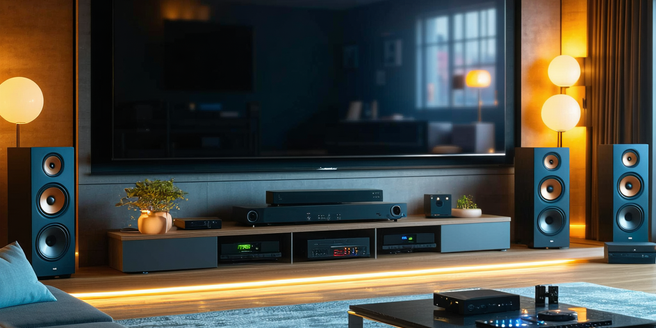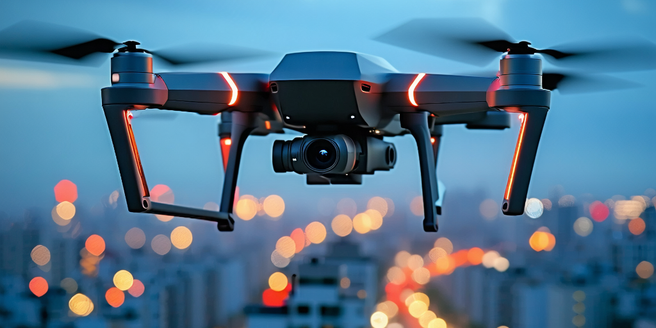
Home Theater Systems For Relaxation
Understand the essentials of creating a home theater system that brings the cinematic experience to your living space. Choose the right equipment, factoring in room size and seating arrangements, to ensure immersive visuals and optimal sound. Learn the importance of audio quality, from surround sound speaker placement to AV receiver calibration, enhancing the emotional impact of films. Discover how to set up a relaxing viewing atmosphere through soundproofing, ambient lighting, and ergonomic seating. Optimize comfort with ergonomic design, climate control, and acoustic treatment. These elements transform your home into a personalized cinema, perfect for every movie night.

Quantum Computing In Consumer Tech
Quantum computing is an emerging field utilizing quantum mechanics for information processing, potentially revolutionizing numerous industries with its advanced capabilities. Quantum computers leverage qubits, enabling massive computational power through phenomena like superposition and entanglement, offering solutions beyond the scope of classical computers. Quantum technology promises to elevate everyday devices, enhancing processing speeds, voice recognition, AI, and security in consumer electronics. Leading companies such as Google, IBM, and Microsoft are investing heavily in quantum research, while firms like Rigetti and D-Wave focus on accessibility and innovation. However, adoption faces challenges like the need for ultra-cold environments, high error rates, and scalability issues. Despite these barriers, ongoing advancements point towards the transformative integration of quantum computing in consumer tech, with a future of powerful, efficient, and secure electronic devices.

Home Automation For Accessibility
Understanding accessibility needs in home automation is essential for creating an inclusive smart home environment. By recognizing diverse abilities, solutions like voice-activated devices and intuitive interfaces can enhance independence and quality of life. Selecting the right smart devices is crucial for ease of use, with features like voice control and large displays being particularly helpful. Integrating voice-controlled assistants empowers users by enabling hands-free operation of home devices, fostering independence. Automated home features such as adjustable countertops and robotic vacuum cleaners enhance mobility by reducing the need for manual interaction. Creating a user-friendly interface involves considering various disabilities, with features like simple navigation and customizable settings improving accessibility. Ultimately, focusing on accessibility in smart homes promotes independence and enhances the user experience for individuals with diverse needs.

Streaming Services For Enhanced Entertainment
Explore the dynamic evolution of streaming platforms, driven by technological advancements and consumer preferences. Discover top streaming services like Netflix, Disney+, Hulu, Prime Video, and HBO Max, each offering unique content and features. Compare their pricing, content variety, and benefits to find the best fit for your needs. Dive into must-watch streaming originals such as 'Stranger Things,' 'The Marvelous Mrs. Maisel,' and 'The Mandalorian,' showcasing high-quality, exclusive content. Learn strategies to maximize your subscription value by understanding viewing habits, utilizing free trials, and exploring bundled offers for cost efficiency. Stay informed and make the most of your streaming experience with these insights.

Biotechnology And Human Health
Biotechnology is transforming healthcare with innovative solutions for diagnosing, treating, and preventing diseases through cellular and biomolecular processes. This field is central to genetic testing, which enables early detection of genetic disorders and personalized medicine development based on individual genetic profiles. Techniques like CRISPR drive advancements in gene editing, offering precise interventions. Genetic engineering in modern medicine allows for altering genetic material to prevent or cure diseases, leading to gene therapies targeting genetic disorders and production of vital biopharmaceuticals. Biotechnology also enhances disease prevention via advanced vaccines and early diagnostic tools, improving public health responses. Personalized medicine has been revolutionized by biotechnology, allowing treatments tailored to individual genetic makeups for more effective healthcare. However, ethical considerations, such as genetic privacy and equitable access, highlight the need for careful discourse and regulatory oversight in biotechnology advancements.

Wearable Technology For Mindful Living
Wearable technology for mindfulness extends beyond fitness tracking to enhance mental well-being by monitoring stress levels and offering relaxation feedback. These devices promote daily mindful habits, reducing anxiety and improving focus. Integrating mindfulness with wearables offers real-time data, guided breathing exercises, and personalized routines, fostering mental resilience and improved sleep. Popular devices like the Muse headband, Fitbit's Versa series, and the Apple Watch encourage mindful living through meditation and stress management features. Choosing the right device involves assessing personal goals and lifestyle compatibility. Practical use involves setting clear objectives, using device alerts for mindfulness reminders, and balancing tech with offline activities. Embracing wearables for mindfulness supports mental health and cultivates a balanced life.

Video Meeting Tools For Diverse Needs
Video meeting tools have become vital for businesses, educators, and individuals, enabling seamless remote communication by bridging geographical distances. When selecting a tool, consider ease of use, supported devices, integration capabilities, video and audio quality, security, and collaboration features. Key options for large teams include Zoom, Microsoft Teams, and Cisco Webex, known for supporting high participant numbers and offering interactive features. Affordable solutions for startups include Google Meet, Zoom, and Jitsi Meet. Educators benefit from platforms like Google Classroom, Zoom, and Microsoft Teams for Education, which provide intuitive and educational-focused features. For corporate use, advanced security is critical, with Zoom, Microsoft Teams, and Cisco Webex offering robust encryption and data protection. As technology progresses, these tools continue to enhance productivity and interactions across various sectors.

Cutting-edge Video Conferencing Technologies
Video conferencing has evolved significantly from its origins with cumbersome, expensive hardware to today's seamless, cloud-based systems. Modern tools offer high-definition video, screen sharing, and real-time collaboration, enhanced by AI features such as auto-framing and noise suppression. Security is a priority, with platforms implementing end-to-end encryption and multi-factor authentication to protect sensitive information. As technology advances, trends like augmented and virtual reality, enhanced AI, and 5G are set to further transform the video conferencing experience. These developments facilitate efficient, secure, and immersive communication across the globe, making video conferencing an integral part of daily life.

Ai In Autonomous Drones
AI integration in drone technology marks a significant advancement in robotics, transforming drones from simple remote devices to autonomous machines. Enhanced by AI algorithms, drones can now process data in real-time, improve decision-making, and learn adaptively. Features such as object recognition, obstacle detection, and optimized flight paths exemplify these advancements, expanding drone applications in logistics, agriculture, and surveillance. AI refines drone navigation, offering precise control even in GPS-denied areas through sensor fusion and machine learning. Safety is enhanced with real-time collision avoidance and predictive maintenance, ensuring reliable and secure operations. AI-powered drones are revolutionizing industries, optimizing tasks in agriculture, construction, public safety, and logistics. Future prospects for AI in drones are bright, with emerging technologies promising even greater autonomy and innovative applications.

Marketing Automation Platforms
Marketing automation leverages software to enhance marketing processes like customer segmentation, data integration, and campaign management, boosting efficiency and personalization. Top marketing automation platforms feature robust analytics, CRM integration, and A/B testing tools, enabling targeted messaging and comprehensive marketing ecosystems. Benefits include improved efficiency, customer engagement, and scalability, leading to higher conversion rates and better resource allocation. Popular platforms like HubSpot and Mailchimp offer user-friendly interfaces, while Marketo and ActiveCampaign provide advanced customization. Successful implementation involves strategic planning, data organization, and continuous optimization. Future trends point to increased personalization through AI, predictive analytics, and a focus on data privacy.

Online Platforms For Nutrition Advice
The growing necessity of online nutrition guidance is evident in today's fast-paced world, where maintaining a balanced diet is increasingly challenging. As obesity rates rise, proper nutrition is critical, and digital platforms provide a convenient, personalized solution. These platforms offer tailored advice for weight management, athletic performance, and dietary restrictions, making nutrition accessible for those unable to attend in-person consultations. Evaluating the credibility of such platforms is crucial; users should seek ones run by certified professionals and backed by scientific research. Many online platforms like MyFitnessPal, Cronometer, and Noom have become leaders in offering diverse resources such as dietary plans, tracking tools, and expert consultations. Choosing the right platform requires considering personal health goals, support level, and cost. The benefits of online resources include accessibility, personalized guidance, and an extensive array of educational materials, effectively supporting modern dietary management.

Energy Efficiency Through Smart Plugs
Smart plugs are innovative devices that connect to home appliances, enabling control via smartphone apps or voice commands. By managing power supply, they enhance convenience and energy efficiency. These devices provide real-time energy usage data, helping reduce consumption and improve safety by allowing remote control of forgotten appliances. Smart plugs contribute to sustainability by optimizing electricity usage and lowering electricity bills. Choosing the right smart plug involves considering functionality, compatibility, and budget. Integration with home automation systems streamlines control and further boosts efficiency. Case studies show significant energy savings in both residential and business settings, demonstrating smart plugs' role in cost reduction and environmental conservation. Future trends include AI integration, promising advancements in smart plug technology.